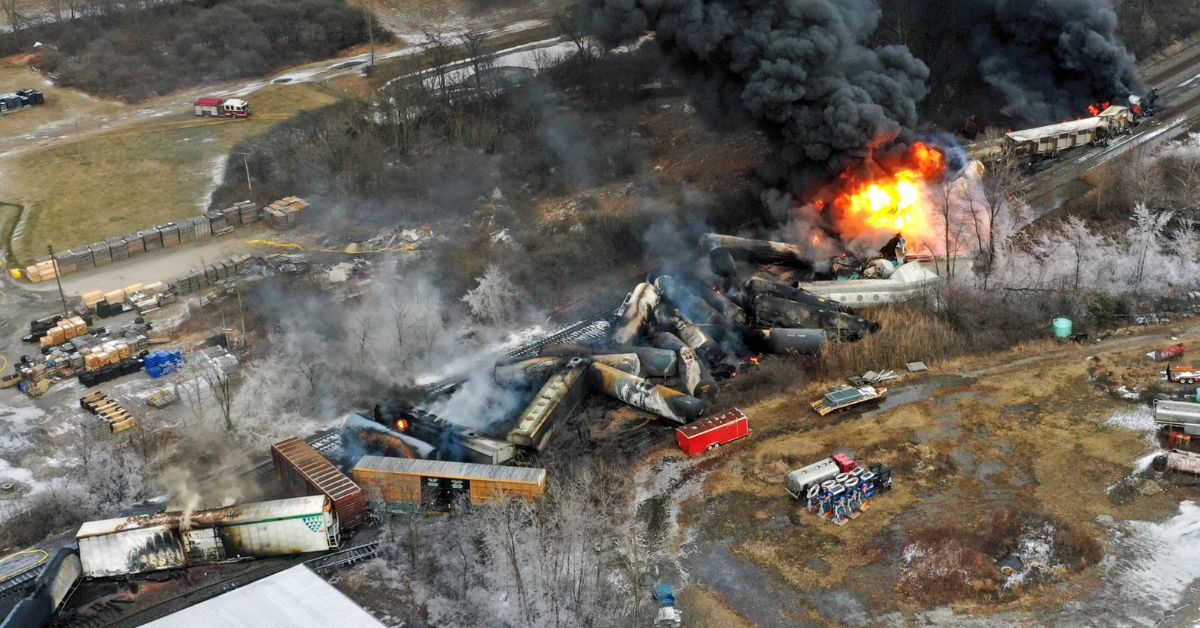Beaver County, Pennsylvania, residents watched anxiously Monday as authorities released a hazardous chemical gas into the air after it had been sitting in train cars for days following a horrific crash in Ohio. Late in the afternoon, a controlled release of vinyl chloride, an industrial chemical, had been scheduled.
After a 50-car derailment on Friday left the scene blazing for days, officials in both states spent the day advising locals to evacuate a 1-2 mile radius around the small Ohio community of East Palestine, located approximately 50 miles northwest of Pittsburgh. Earlier on Monday, Pennsylvania Governor Josh Shapiro warned anyone in the “red zone” from the derailment site into Beaver County to leave immediately or risk their lives.
Within a few days or hours, you could suffer irreversible lung damage if you’re anywhere in the orange area on this map. Dan Potts witnessed the smoke column rise in the minutes after the gas was unleashed, long after he had left his home in Darlington Township, Beaver County. Over the course of the next hour, he saw the sky becoming progressively darker as the smoke moved in.

He summed up the sight before him with the words,
“strange, not something I’ve ever seen before.”
At 5:30 p.m., dense smoke clouds obscured much of the sky in the area around Chippewa Township. Light breezes were present in the early evening, and it was unclear whether or not they would carry the smoke into Beaver County. At 8 o’clock, Mr. Shapiro delivered a briefing in which he assured everyone that, despite the spectacular images, the controlled release was proceeding as expected and would soon be coming to a close.
According to him, the state is still keeping an eye on the air quality near the fire, and
“thus far no concerning readings have been detected.”
“Out of an abundance of caution,”
Mr. Shapiro encouraged Pennsylvanians who live within a two-mile radius of the train derailment to remain indoors with their windows and doors closed.
He assured us,
“We will learn from this.”
Ohio Governor Mike DeWine warned earlier that the vinyl chloride in five train carriages was unstable and may explode, which would have released lethal toxic vapors and shrapnel. The danger of shrapnel, which may travel up to a mile in the event of an explosion, would be reduced thanks to the gas’s controlled release, he claimed.
Mr. DeWine explained,
“We had to assess various risks with no excellent alternatives.”
At about 5 o’clock, the rail company Norfolk Southern said that “the controlled breach of multiple rail carriages has been performed successfully.”
The business reported that
“Some of the material is now burning off consistent with expectations from the earlier models, and is expected to drain for a short number of hours,”
And that the draining process was predicted to take a relatively small number of hours.
“We have been, and will continue, monitoring air quality with the Ohio EPA.”
At roughly the same moment, a dozen or so vehicles stopped at the Chippewa crossroads of Route 51 and Route 168 to observe the aftermath. One of the highways that was closed during the town’s evacuation was Route 51, which extends into Darlington. An officer with the South Beaver Township police department said the road will remain closed “till this time tomorrow,” or until approximately 5:30 p.m. on Tuesday.
You may also check out the links that we have provided further down the page:
- Shots In Mckeesport Kill One Police Officer And Hurt Another
- Biden Meets With Congressional Black Caucus on Police Reform
- After Tyre Nichols Death, Many in New Jersey have Questioned the Police’s Credibility
Mr. Potts, who spent the past week on a ski trip in Utah, was present to take in the sights. His loved ones had kept him apprised of the train derailment throughout the weekend, but he “didn’t know how severe it was” until he got to Pennsylvania and discovered he couldn’t return home.
Earlier, Norfolk Southern’s regional manager Scott Deutsch indicated that a controlled burn of the vinyl chloride was the “safest path” forward. He explained that the employees would drill a hole 2.5 to 3 inches wide in each tank car so the gas could flow freely.
In the absence of this action, “the car could continue to polymerize and the entire car could come apart,” Mr. Deutsch said. It’s because we have no say over where that might go that we’re taking this step. Even before officials started warning of the controlled release, the region was still dealing with the fallout.
On Monday, when the weather deteriorated, schools in the Blackhawk and Western Beaver districts in Beaver County sent their kids home early. The United States Environmental Protection Agency (EPA) has installed real-time air monitoring equipment at 12 locations and deployed air monitoring crews to conduct localised measurements.

Air samples have also been collected and sent to a facility for further study, with preliminary results due on Wednesday. Chemicals like vinyl chloride and butyl acrylate, which were being transported by the train, are being measured by the monitors.
“levels of carbon monoxide, oxygen, hydrogen sulfide, hydrogen cyanide, phosgene, and hydrogen chloride, as well as measuring the flammability of gases in the perimeter.”
About 50 railroad cars derailed late on Friday in East Palestine, some of them carrying dangerous commodities. This caused a major fire. On Sunday, Mr. DeWine urged anybody living within a mile of the site to evacuate immediately in case of a “major explosion.”
Mr. DeWine claims that he dispatched sheriffs and other law enforcement authorities from the Ohio State Highway Patrol to the region on Sunday, urging any remaining residents to evacuate in advance of Monday’s controlled release. In addition, he sent in the Ohio National Guard on Sunday night to help local authorities with the evacuation.

